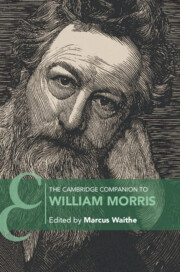Book contents
- The Cambridge Companion to William Morris
- The Cambridge Companion to William Morris
- Copyright page
- Dedication
- Contents
- Figures
- Notes on Contributors
- Acknowledgements
- Note on The Collected Works
- Chronology
- Abbreviations
- Introduction
- Part I Senses of Place
- Part II Authorship
- Part III The Practical Arts
- Chapter 12 Morris & Company
- Chapter 13 Pattern
- Chapter 14 Technologies of the Book
- Part IV Movements and Causes
- Part V Influences and Legacies
- Guide to Further Reading
- Index
- Cambridge Companions To …
Chapter 14 - Technologies of the Book
Revisiting the Kelmscott Press
from Part III - The Practical Arts
Published online by Cambridge University Press: 03 May 2024
- The Cambridge Companion to William Morris
- The Cambridge Companion to William Morris
- Copyright page
- Dedication
- Contents
- Figures
- Notes on Contributors
- Acknowledgements
- Note on The Collected Works
- Chronology
- Abbreviations
- Introduction
- Part I Senses of Place
- Part II Authorship
- Part III The Practical Arts
- Chapter 12 Morris & Company
- Chapter 13 Pattern
- Chapter 14 Technologies of the Book
- Part IV Movements and Causes
- Part V Influences and Legacies
- Guide to Further Reading
- Index
- Cambridge Companions To …
Summary
The archaic appearance of the Kelmscott Press publications can lend the impression of revivalism in its fundamentalist form. This chapter considers the modern (and partially modern) technologies employed by Morris’s bookmaking venture, ranging from Emery Walker’s method of photographic enlargement in the development of typefaces, to the employment of early nineteenth-century metal presses. The discussion focuses initially on Morris’s broader relationship with technology, including the influence of John Ruskin. As with Ruskin, an initial impression of hostility to all mechanised solutions gives way to qualifications based in the form of energy harnessed, the context of the work, and the relationship with human agency or intelligence. Morris’s account of weaving provides a particularly suggestive basis for rethinking his relationship with technology, and this opens the way for a discussion of two lens-based solutions which he applied to work at the printing press. The first relates to the mediation of the hand by photographic means, most notably Burne-Jones’s hand as designer of the Press’s woodcuts. The second concerns technologies of projection and enlargement, initially employed by Walker at the ‘magic lantern’ lecture that inspired the foundation of the Press, and then in the design of typefaces based on early Venetian models.
- Type
- Chapter
- Information
- The Cambridge Companion to William Morris , pp. 188 - 200Publisher: Cambridge University PressPrint publication year: 2024



